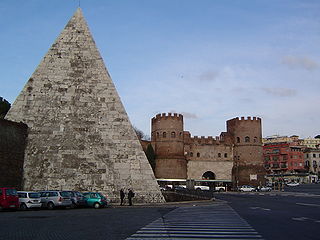
Ponte is the 5th rione of Rome, Italy, identified by the initials R. V, and is located in Municipio I. Its name comes from Ponte Sant'Angelo, which connects Ponte with the rione of Borgo. This bridge was built by Emperor Hadrian in 134 AD to connect his mausoleum to the rest of the city. Though Pope Sixtus V changed the rione limits, so that the bridge belongs now to Borgo, not to Ponte anymore, the area has kept its name and a bridge as its coat of arms.

Sant'Angelo is the 11th rione of Rome, Italy, located in Municipio I. Often written as rione XI - Sant'Angelo, it has a coat of arms with an angel on a red background, holding a palm branch in its left hand. In another version, the angel holds a sword in its right hand and a scale in its left.

Testaccio is the 20th rione of Rome, Italy, identified by the initials R. XX, deriving its name from Monte Testaccio. It is located within the Municipio I. Its coat of arms depicts an amphora, referencing to the broken vessels that Monte Testaccio is made of.

Prati is the 22nd rione of Rome, Italy, identified by the initials R. XXII. It belongs to the Municipio I since 2013, while previously, along with Borgo and quartieri Trionfale and Della Vittoria, it was part of the Municipio XVII.

Campo Marzio is the 4th rione of Rome, Italy, identified by the initials R. IV. It belongs to the Municipio I and covers a smaller section of the area of the ancient Campus Martius. The logo of this rione is a silver crescent on a blue background.

The Via Giulia is a street of historical and architectural importance in Rome, Italy, which runs along the left (east) bank of the Tiber from Piazza San Vincenzo Pallotti, near Ponte Sisto, to Piazza dell'Oro. It is about 1 kilometre long and connects the Regola and Ponte Rioni.

San Salvatore in Lauro is a Catholic church in central Rome, Italy. It is located on a piazza of the same name in the rione Ponte. It stands on Via Vecchiarelli, just south of the Lungotevere Tor di Nona and north of via dei Coronari. It is the "national church" of the marchigiani, the inhabitants of the Marche region of Italy. The current protector of this titulus is Cardinal-Deacon Angelo Comastri.

Scipione affricano is an opera in a prologue and three acts by Francesco Cavalli. It was designated as a dramma per musica. The Italian libretto was by Nicolò Minato, based on Livy's "The Continence of Scipio".
Apollo Theatre or Apollo Theater may refer to:

The Teatro Santi Giovanni e Paolo was a theatre and opera house in Venice located on the Calle della Testa, and takes its name from the nearby Basilica of Santi Giovanni e Paolo, Venice. Built by the Grimani family in 1638, in its heyday it was considered the most beautiful and comfortable theatre in the city. The theatre played an important role in the development of opera and saw the premieres of several works by Francesco Cavalli, as well as Monteverdi's Il ritorno d'Ulisse in patria and L'incoronazione di Poppea.

Lungotevere is an alley or boulevard running along the river Tiber within the city of Rome. The building of the Lungoteveres required the demolition of the former edifices along the river banks and the construction of retaining walls called muraglioni.

The Lungotevere dei Mellini is the stretch of Lungotevere that links Via Vittoria Colonna to Piazza della Libertà, in the rione Prati in Rome (Italy).

Lungotevere Gianicolense is the stretch of Lungotevere that links Piazza della Rovere to Ponte Mazzini in Rome (Italy), in the Rione Trastevere.

Via dei Coronari is a street in the historic center of Rome. The road, flanked by buildings mostly erected in the 15th and the 16th century, belongs entirely to the rione Ponte and is one of the most picturesque roads of the old city, having maintained the character of an Italian Renaissance street.

Lungotevere Tor di Nona is the stretch of Lungotevere that connects Piazza di Ponte Sant'Angelo to Piazza di Ponte Umberto I in Rome, in the rione Ponte. It was named so following the resolution of the city council of 20 July 1887.
Giovanni Filippo Apolloni was an Italian poet and librettist. Born in Arezzo, he has sometimes been referred to as "Giovanni Apollonio Apolloni", but the second given name is spurious. He served as the court poet to Ferdinand Charles, Archduke of Austria at Innsbruck form 1653 until 1659. On his return to Italy he entered the service of Cardinal Volumnio Bandinelli. After Bandinelli's death in 1667 Appolloni was in the service of the Chigi family in Rome and Siena for the rest of his life. He wrote the librettos for a number of operas, the most well-known of which were Antonio Cesti's L'Argia and La Dori, as well as several oratorios and the texts for cantatas by both Cesti and Alessandro Stradella.

The following outline is provided as an overview of and topical guide to Rome:

The Carceri Nuove was a prison built in the mid-17th century at the instigation of Pope Innocent X and his ideals of humanity and clemency. The New Jails were to replace other prisons throughout the city. This jail remained in operation until the construction of the judicial prison of Regina Coeli in Trastevere at the turn of the 20th century. The building, in 2020, housed the Direzione Nazionale Antimafia e Antiterrorismo.
Antonia "Tonia" Coresi was an Italian opera soprano.
Angela "La Giorgina" Voglia was an Italian opera soprano.

















